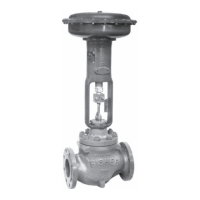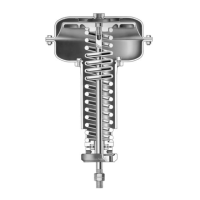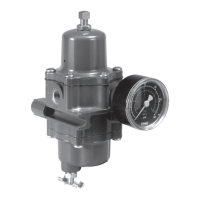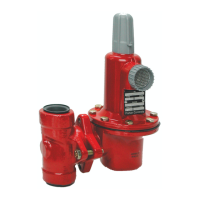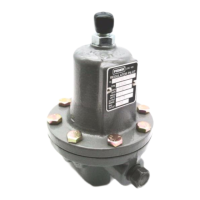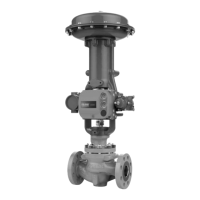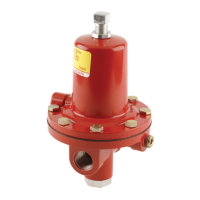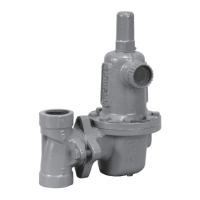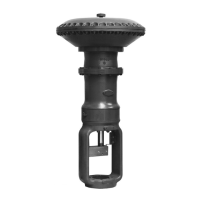630 Series
3
Table 2. Type 630 Regulator Outlet Pressure Ranges and Maximum Outlet Pressures
REGULATOR
CONSTRUCTION
OUTLET PRESSURE RANGE
SPRING PART
NUMBER
MAXIMUM OPERATING
OUTLET PRESSURE
MAXIMUM OUTLET
PRESSURE
OVER SETPOINT
(1)
MAXIMUM EMERGENCY
OUTLET (CASING)
PRESSURE
(4)
psig bar psig bar psig bar psig bar
Low-Pressure
3 to 10 0.21 to 0.69 0W019227022 10 0.69
20 1.38
66 4.55
8 to 20 0.55 to 1.38 0W019127022 20 1.38
17 to 30 1.17 to 2.07 0W019027022 30 2.07 20
(2)
1.38
(2)
27 to 40 1.86 to 2.76 0Y066427022 40 2.76
Limited by Maximum
Emergency Outlet Pressure
High-Pressure
27 to 50
46 to 95
90 to 150
150 to 200
200 to 275
1.86 to 3.45
3.17 to 6.55
6.21 to 10.3
10.3 to 13.8
13.8 to 19.0
0W019227022
0W019127022
0W019027022
0Y066427022
1J146927142
50
95
150
200
275
3.45
6.55
10.3
13.8
19.0
200 13.8
550 37.9
275 to 500 19.0 to 34.5 1K370927082 500 34.5 200
(3)
1.38
(2)
1. Damage to internal parts of the regulator may occur if outlet pressure exceeds the actual pressure setting by amounts greater than those shown in this column.
2. For outlet pressure settings to 25 psig / 1.72 bar only. For pressure settings over 25 psig / 1.72 bar, outlet pressure is limited by maximum emergency outlet pressure of 45 psig / 3.10 bar.
3. For outlet pressure settings to 350 psig / 24.1 bar only. For pressure settings over 350 psig / 24.1 bar, outlet pressure is limited by maximum emergency outlet pressure of 550 psig / 37.9 bar.
4. Leakage or bursting of pressure-containing parts may occur if outlet pressure exceeds these values.
Table 3. Type 630R Relief Pressure Ranges
RELIEF VALVE
CONSTRUCTION
RELIEF (INLET)
PRESSURE RANGE
PART NUMBER
MAXIMUM ALLOWABLE
RELIEF (INLET) PRESSURE,
psig / bar
MAXIMUM EMERGENCY
INLET (CASING) PRESSURE
(1)
psig bar psig bar
Low-Pressure
3 to 8
6 to 17
15 to 22
20 to 35
35 to 50
0.21 to 0.55
0.41 to 1.17
1.03 to 1.52
1.38 to 2.41
2.41 to 3.45
0W019227022
0W019127022
0W019027022
0Y066427022
1J146927142
Relief Pressure Setting Plus
Maximum Allowable Buildup of
25 psig / 1.72 bar
75 5.17
High-Pressure
30 to 70
50 to 95
75 to 175
150 to 250
2.07 to 4.83
3.45 to 6.55
5.17 to 12.1
10.3 to 17.2
0W019127022
0W019027022
0Y066427022
1J146927142
Relief Pressure Setting Plus
Maximum Allowable Buildup of
250 psig / 17.2 bar
550 37.9
1. Leakage or bursting of pressure-containing parts may occur if inlet pressure exceeds these values.
To avoid overpressure, provide an
appropriate overpressure protection
device to ensure that none of the limits
listed in Specications section, Tables 1
through 3 will be exceeded.
Regulator or relief valve operation below the limits
specied in Specications section, Tables 1 through 3
does not preclude the possibility of damage from external
sources or from debris in the gas line. Inspect the
regulator for damage after any overpressure condition.
Startup
Starting up the unit consists of opening the upstream
block valve, introducing gas pressure. Use gauges to
monitor pressures during startup.
The range of allowable pressure settings is marked
on the nameplate. If a pressure setting beyond the
nameplate range is required, substitute an appropriate
spring selected from Table 5. Be sure to change the
nameplate to indicate the new pressure range.
Table 1. Maximum Allowable Inlet Pressures and Pressure Drops
ORIFICE SIZE
MAXIMUM ALLOWABLE
INLET PRESSURE
(1)
MAXIMUM ALLOWABLE PRESSURE DROP
Nylon (PA)
(2)
and
Polytetrauoroethylene
(PTFE) Disk
Fluorocarbon (FKM) Disk Nitrile (NBR)
(2)
Disk
In. mm psig bar psig bar psig bar psig bar
1/8 and 3/16 3.2 and 4.8
1500 103
1500 103
200 13.8
600 41.4
1/4 6.4 1000 69
3/8 9.5 1000 69 500 34.5 500 34.5
1/2 13 750 51.7 250 17.2 250 17.2
Note: Maximum inlet pressure not exceeded 1500 psig / 103 bar.
1. Inlet pressure must not exceed the sum of the actual outlet pressure setting and the maximum allowable pressure drop. For example, with an outlet pressure setting of 200 psig / 13.8 bar
and a 3/8 in. / 9.5 mm orice with a maximum allowable pressure drop of 500 psid / 34.5 bar d, the maximum inlet pressure is 700 psig / 48.3 bar.
2. Nitrile (NBR) valve disks are normally furnished for pressure drops to 200 psi / 13.8 bar, differential. For better erosion resistance, Nylon (PA) valve disks are normally furnished for
higher
pressure drops. Some erosion of valve disks occurs at all pressure drops due to solid particles in the ow stream. The rate of erosion is higher with large amounts of impurities in the
ow stream and with high pressure drops. Valve disks and other regulator parts must be inspected periodically for erosion and damage and must be replaced as necessary.
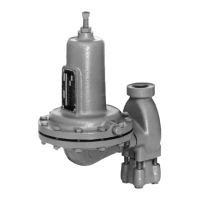
